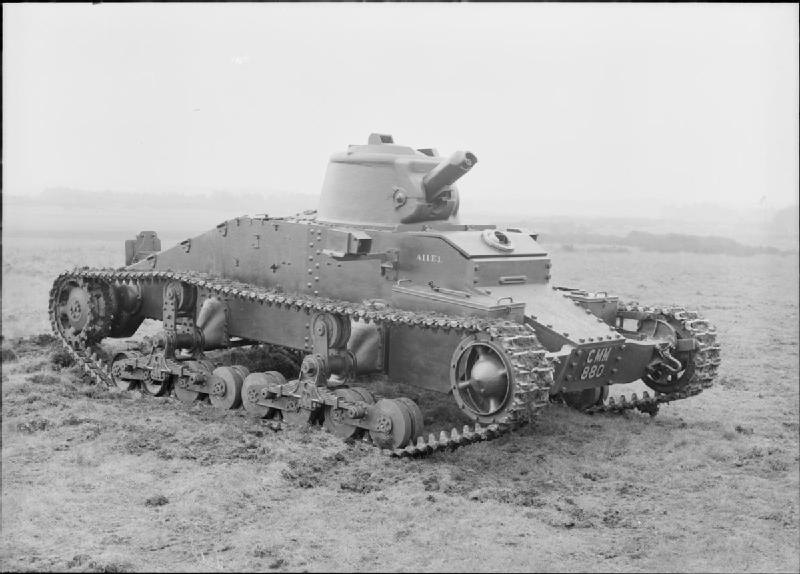|
Matilda Mk. I
The Tank, Infantry, Mk I, Matilda I (A11) was a British infantry tank of the World War II, Second World War. Despite being slow, cramped and armed with only a single machine gun, the Matilda I had some success in the Battle of France in 1940, owing to its heavy Vehicle armour, armour which was proof against the standard German anti-tank guns. However, it was essentially useless in an attacking sense, as its weak armament made it toothless in combat against enemy armour, and the tank was obsolete before it even came into service. The Battle of France was the only time the Matilda I saw combat. The tank was cheaply built as the British government wanted each of the tanks to be built on a very restricted budget in the build-up to the Second World War. It is not to be confused with the later (more successful) model Matilda II tank, Tank, Infantry Mk II (A12), also known as the "Matilda II", which took over the "Matilda" name after the Matilda I was withdrawn from combat service in 1940 ... [...More Info...] [...Related Items...] OR: [Wikipedia] [Google] [Baidu] |
Gun Turret
A gun turret (or simply turret) is a mounting platform from which weapons can be fired that affords protection, visibility and ability to turn and aim. A modern gun turret is generally a rotatable weapon mount that houses the crew or mechanism of a projectile-firing weapon and at the same time lets the weapon be aimed and fired in some degree of azimuth and elevation (cone of fire). Description Rotating gun turrets protect the weapon and its crew as they rotate. When this meaning of the word "turret" started being used at the beginning of the 1860s, turrets were normally cylindrical. Barbettes were an alternative to turrets; with a barbette the protection was fixed, and the weapon and crew were on a rotating platform inside the barbette. In the 1890s, armoured hoods (also known as "gun houses") were added to barbettes; these rotated with the platform (hence the term "hooded barbette"). By the early 20th Century, these hoods were known as turrets. Modern warships have gu ... [...More Info...] [...Related Items...] OR: [Wikipedia] [Google] [Baidu] |
British Expeditionary Force (World War II)
The British Expeditionary Force (BEF) was the name of the contingent of the British Army sent to France in 1939 after Britain and France declared war on Nazi Germany on 3 September, beginning the Second World War. The BEF existed from 2 September 1939 when the BEF GHQ was formed until 31 May 1940, when GHQ closed down and its troops reverted to the command of Home Forces. During the 1930s, the British government had planned to deter war by abolishing the Ten Year Rule and rearming from the very low level of readiness of the early 1930s. The bulk of the extra money went to the Royal Navy and the Royal Air Force but plans were made to re-equip a small number of Army and Territorial Army divisions for service overseas. General Lord Gort was appointed to the command of the BEF on 3 September 1939 and the BEF began moving to France on 4 September 1939. The BEF assembled along the Belgian–French border. The BEF took their post to the left of the French First Army under the com ... [...More Info...] [...Related Items...] OR: [Wikipedia] [Google] [Baidu] |
Royal Tank Regiment
The Royal Tank Regiment (RTR) is the oldest tank unit in the world, being formed by the British Army in 1916 during the First World War. Today, it is the armoured regiment of the British Army's 12th Armoured Infantry Brigade. Formerly known as the Tank Corps and the Royal Tank Corps, it is part of the Royal Armoured Corps. History First World War The formation of the Royal Tank Regiment followed the invention of the tank. Tanks were first used at the Battle of Flers–Courcelette in September 1916 during the Battle of the Somme in the First World War. They were at first considered artillery, and crews received artillery pay. At that time the six tank companies were grouped as the Heavy Section of the Machine Gun Corps (MGC). In November 1916 the eight companies then in existence were each expanded to form battalions (still identified by the letters A to H) and designated the Heavy Branch MGC; another seven battalions, I to O, were formed by January 1918, when all the battalions ... [...More Info...] [...Related Items...] OR: [Wikipedia] [Google] [Baidu] |


